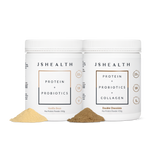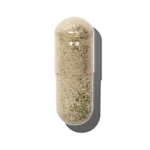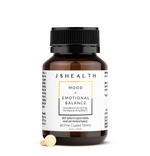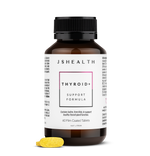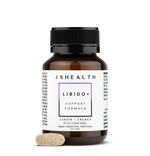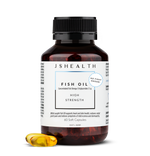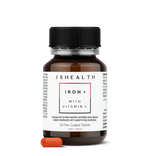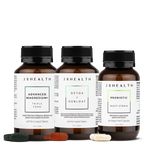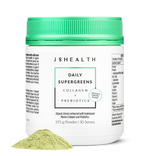Huge savings sitewide + claim FREE gift!
Stomach Pain After Eating? Two Things It Could Be
Feeling uncomfortable after a meal can really put a damper on your day. We’ve all been there. That sudden pain and discomfort can quickly turn a social gathering or a night out into a nerve-wracking experience.
Could it be a sign or symptom of a more significant problem? Together, we’ll explore the different factors that might contribute to your tummy troubles and offer some practical tips for managing and preventing the discomfort.
Types of Stomach Pain (and Other Symptoms)
Stomach pain doesn’t always happen the same way for everyone — for some people, symptoms can vary from meal to meal. Because stomach pain, discomfort, and other related gastrointestinal symptoms can be diverse (and occasionally mistaken for something else), it’s important to touch on these briefly before exploring potential triggers.
- Acid reflux — Also known as heartburn, acid reflux happens when stomach acid travels from the stomach and back up into the oesophagus, causing a burning sensation in the chest or throat.
- Bloating — Abdominal bloating can be something that is often felt, like a sense of tightness throughout your digestive system. In some cases, bloating can get so severe that it can also be visibly seen from the outside.
- Burning — Sometimes, a stomach ache can feel like burning, which can occur anywhere in the stomach and even travel up into the arm and chest. However, because arm and chest pain can also be a sign of a myocardial infarction (heart attack), check with a healthcare professional if you experience a new or sudden onset of those symptoms.
- Cramping or pain — Abdominal cramping can take many forms, from sharp and stabbing abdominal pain to dull and achy sensations. Stomach cramps can also vary in duration, intensity and location (depending on where the issue stems from the GI tract). Cramping can occur as far up as under the rib cage and as far down below the pelvic bones. A medical provider should evaluate severe pain as soon as possible, as it could be an emergency.
- Diarrhoea — Often, the result of all that cramping and stomach pain after eating is diarrhoea. Diarrhoea doesn’t always have to mean liquid stool; it can also be just looser than usual or come with an increased sense of urgency.
- Gas — Gas can be painful and embarrassing, but it is one of the more common signs of a digestive tract issue (especially if it happens after eating).
- Fullness — Getting uncomfortably full too quickly or feeling uncomfortably full, even after a small meal.
- Nausea and vomiting — An upset stomach after eating, or even potentially vomiting, is another common symptom of GI issues.
What Can Trigger Stomach Pain After Eating?
If any of the above symptoms sound familiar, you’ll know just how uncomfortable and demanding GI issues can be. But what triggers that pain?
There are two main reasons stomach pain after eating can happen, so we’ll look at both in more detail.
1. Food
We’re all guilty of overeating something we know is “bad” for us and immediately paying the price — there are even entire holidays based around it (think along the lines of that mighty Easter spread). But when stomach pain after eating becomes the norm instead of a one-off, it’s time to consider what may be happening inside your body to trigger that physical reaction.
Food allergies are one way that food can trigger stomach pain and discomfort. With a food allergy, any contact with the food you’re allergic to causes the immune system to react to it like it would any other invader.
While you can be allergic to anything, people more commonly react to things like dairy, eggs, fish, nuts (especially peanuts), soy and wheat. In severe cases, food allergies can even lead to a life-threatening allergic reaction called anaphylaxis.
You can also be simply “intolerant” to certain foods, enough to cause a reaction or irritation in your body without involving the immune system. You can have lactose intolerance, have an issue digesting gluten and be sensitive to FODMAPs (fermentable, oligo-, di-, mono-saccharides and polyols foods like apples, asparagus and legumes).
Indigestion, often due to a dietary “indiscretion” like eating too much acidic, greasy, or fatty food, can also trigger stomach pain after eating. While this may also be related to a medical issue (like gallbladder inflammation), it can sometimes just be a reminder that we need to be more mindful of what we choose to put in our bodies. We only get one, after all!
2. Medical Issues
Specific health issues can also trigger stomach pain after eating. If you suspect you may be dealing with any issues we’re about to discuss, schedule an appointment with your physician to discuss them further and possibly pursue diagnostic testing.
- Acute pancreatitis — The pancreas can become inflamed for multiple reasons, like gallstones or excessive or chronic alcohol consumption. If it becomes inflamed, the condition can be excruciatingly painful. Pain due to pancreatitis is usually located in the upper abdomen but also radiates around into the back.
- Coeliac Disease — Although many people claim to be gluten intolerant, only about one percent of people globally have been diagnosed with coeliac disease. Unlike an intolerance, coeliac disease involves the immune system (much like an allergic reaction). Repeated exposure to gluten can cause damage to the lining of the small intestine, triggering symptoms like stomach pain and upset, as well as other health complications.
- Constipation — Constipation (difficult to pass or infrequent bowel movements) can happen for many reasons. However, if that constipation becomes a chronic issue — meaning you have three or fewer bowel movements over several weeks — it can cause stomach pain and bloating.
- Crohn's Disease — Crohn’s Disease is a form of inflammatory bowel disease (IBD), slightly different from IBS. People with Crohn’s Disease experience severe and chronic inflammation of different parts of their GI tract, leading to symptoms like bloody stools, diarrhoea, and pain. Crohn’s Disease also has the potential to be life-threatening if not managed by a medical professional.
- Gastroesophageal Reflux Disease (GERD) — GERD is essentially chronic acid reflux, where stomach acid backs up into your oesophagus. Over time, stomach acid can irritate and even erode the lining of the oesophagus, causing significant pain and discomfort.
- Irritable Bowel Syndrome (IBS) — Where coeliac disease impacts the small intestine, IBS affects the large intestine. IBS is a chronic condition most frequently associated with bowel changes (like diarrhoea, constipation or cycles of both).
- Peptic Ulcers — The body will sometimes develop sores (ulcers) on the stomach lining and duodenum (the upper part of the small intestine). These ulcers can form for various reasons, including stress or as a side effect of certain medications (like ibuprofen). Stomach pain after eating spicy foods or drinking alcohol is the most common symptom.
- Ulcerative Colitis — Ulcerative colitis falls under the IBD label, like Crohn’s Disease. With ulcerative colitis, the body’s immune system responds inappropriately to food-related triggers, which can cause inflammation and ulcers to occur on the inside of the large intestine.
What Can I Do To Support My Stomach?
Anything out of the ordinary happening inside your body can make you feel helpless, but you don’t have to just sit back and let your body run the show. By proactively taking steps to support your body during these symptoms, you can feel more empowered to manage them and continue to live your life to the fullest.
To determine what products will be the most beneficial, start by identifying your specific symptoms. Lifestyle changes may also be part of symptom management. While we don’t want you to have to overhaul your entire life, keeping a food diary can help you look for clues about what (if any) foods may be triggering your stomach pain after eating.
An elimination diet can also be beneficial when you stop eating particular groups of foods (like dairy, gluten or soy) for a short period to evaluate the body’s response. Stomach pain can also have a mental health component, so it’s crucial to also take note of your stress level or any significant life changes when considering potential triggers.
Stress and anxiety can not only cause stomach pain; it can also worsen many of the medical conditions that can trigger them. Mindfulness can be potentially life-changing in all avenues of life – physically, emotionally and mentally.
In Conclusion
Food is a massive part of life, so it can be stressful and anxiety-inducing when eating becomes painful. Stomach pain after eating can force you to change plans and lose your enjoyment of food, but you don’t have to just grin and bear it.
With the right help, you can actively work towards identifying your triggers, managing or relieving your symptoms and potentially seeking an official diagnosis for any medical conditions.
Sources:
Acid Reflux (GER & GERD) in Adults | NIDDK
Heart Attack Symptoms, Risk, and Recovery | CDC





